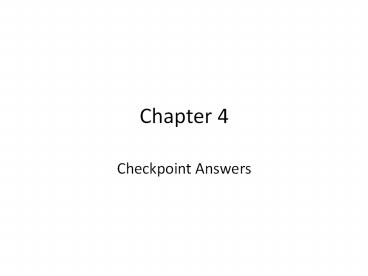Checkpoint Answers PowerPoint PPT Presentation
1 / 13
Title: Checkpoint Answers
1
Chapter 4
- Checkpoint Answers
2
Checkpoint 1
- In the reaction (H2O CO2 ? H2CO3), increasing
the concentration of H2O would - A. decrease the concentration of
H2CO3.B. increase the concentration of
H2CO3.C. increase the concentration of
CO2.D. have no effect on either CO2 or H2CO3
concentrations.
3
Checkpoint 2
- 1. Energy transformations result in a(n)
______________ in entropy.
A. increase B. decrease C. no change - 2. Oxidizing agents accept electrons from
molecules undergoing reduction. (T) - 3. A reducing agent donates electrons to a
molecule. (T) - 4. Exergonic reactions proceed with the release
of energy. (T) - 5. A molecule that gains a hydrogen is also
oxidized. (F) - 6. Chemically reduced FAD has __________ extra
hydrogen atom(s) bound to it. A. one
B. two C. three D. no - 7. Oxidized nicotinamide adenine dinucleotide
(NAD) has ______________ two hydrogens.
A. lost B. gained C. shared
4
Chapter 5
- Checkpoint Answers
5
Checkpoint 1
- 1. ______________ is the opposite of
glycogenesis. A. GlycolysisB. GlyconeogenesisC
. GlycogenolysisD. Gluconeogenesis - 2. Glucose formed from amino acids comes from the
process of glycogenolysis. (F) - 3. The Cori cycle involves formation of glucose
made by gluconeogenesis in the liver from lactic
acid produced by fermentation in skeletal
muscles. (T)
6
Checkpoint 2
- 1. In glycolysis, glucose is converted to
glycogen. (F) - 2. Glycolysis converts glucose into two
______________ molecules. A. glycogen
B. lactic acid C. acetyl CoA D. pyruvic
acid - 3. Acetyl CoA and NAD are the end-products of the
Krebs Cycle. (F) - 4. Each turn of the Krebs cycle produces A. 2
FADH2, 1 ATP, and 3 NADH. B. 1 FADH2, 1
ATP, and 3 NADH.C. 3 FADH2, 2 ATP, and 1 NADH.
D. 1 FADH2, 3 ATP, and 2 NADH - 5. The actual yield of ATP from 1 glucose
is A. 18-20 ATP. B. 36-38 ATP.C. 30-32
ATP. D. 26-28 ATP.
7
Checkpoint 3
- 1. Which of the following can undergo metabolic
conversion to acetyl CoA and enter the Krebs
cycle? A. glucose B. fatty
acidsC. protein D. All of these
choices are correct. - 2. The majority of energy within the body is
stored as triglycerides. (T) - 3. Acetyl CoA A. can enter the Krebs
cycle.B. can reversibly form ketone
bodies.C. can directly form pyruvic
acid.D. Both can enter the Krebs cycle and can
reversibly form ketone bodies. - 4. How many amino acids are essential for an
adult? A. eight B. nine C. ten
D. twelve
8
Chapter 6
- Checkpoint Answers
9
Checkpoint 1
- 1. The majority of water within the body is found
in the A. intracellular compartment. B. extrace
llular compartment.C. blood plasma. D. intersti
tial fluid. - 2. The extracellular matrix is made up of
collagen, elastin, and a gel-like ground
substance. (T) - 3. Active transport does not require the
expenditure of energy. (F) - 4. Proteins that extend from the cytoskeleton
within the cell, through the plasma membrane, and
into the extracellular matrix are A. lysosomal
proteins. B. metallo proteins.C. receptor
proteins. D. integrin proteins.
10
Checkpoint 2
- 1. Passive transport of water is known
as A. filtration. B. osmosis.C. facilitated
diffusion. D. a water pump. - 2. Dialysis uses the process of A. facilitated
diffusion. B. primary active transport.C. simpl
e diffusion. D. secondary active transport. - 3. The rate of diffusion increases as the
concentration gradient increases. (T) - 4. What type of intravenous fluid would be given
to reduce edema? A. hypertonic
B. isotonic C. hypotonic - 5. Explain the difference between osmolarity and
osmolality. (read full explanation in your
testbook)
11
Checkpoint 3
- 1. Protein carrier mediated transport of
molecules display A. specificity. B. competitio
n.C. saturation. D. All of these choices are
correct. - 2. Glucose can enter into the cell by facilitated
diffusion or countertransport. (F fasc. diff or
cotransport) - 3. Active transport carriers are also
called A. vesicles. B. channels.C. pumps. D
. receptors. - 4. What type of functional complex will prohibit
paracellular transport? A. tight
junctions B. adherens junctionsC. desmosomes D.
gap junctions - 5. Movement of large molecules into a cell is
called A. endocytosis. B. exocytosis.C. bulk
transport. D. Both A and C are correct.
12
Checkpoint 4
- 1. The charge difference across a membrane
produces the membrane potential. (T) - 2. The resting membrane potential is closest to
the equilibrium potential for A. sodium
ions. B. chloride ions.C. calcium
ions. D. potassium ions. - 3. Hyperkalemia would ____________ the resting
membrane potential of the cell. A. increase
B. decrease C. have no effect on - 4. A change in the concentration of any ion
inside or outside the cell will change the
resting potential. (T)
13
Checkpoint 5
- 1. Which of the following is NOT a general
category of cell signaling molecules? A. endocrin
e signaling B. enzymatic signalingC. paracrine
signaling D. synaptic signaling - 2. Which of the following is NOT true of cyclic
AMP? A. It is found on the outside of a plasma
membrane.B. It is a second messenger for polar
regulatory molecules.C. It is made from
ATP.D. It activates enzymes inside a cell to
produce the desired effect. - 3. Where is the receptor for a nonpolar,
lipid-soluble regulatory molecule? A. embedded
in the outer surface of the plasma
membraneB. embedded in the inner surface of the
plasma membraneC. in the cytoplasm or nucleus
of the cellD. All of the choices are correct.

